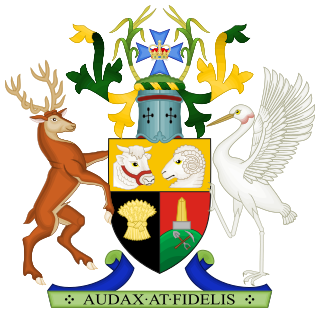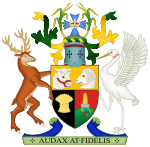
The vice president of India is the deputy to the head of state of the Republic of India, i.e. the president of India. The office of vice president is the second-highest constitutional office after the president and ranks second in the order of precedence and first in the line of succession to the presidency. The vice president is also the ex officio chairman of the Rajya Sabha.
One of the six founding states of Australia, Queensland has been a federated state subject to the Australian Constitution since 1 January 1901. It is a parliamentary constitutional monarchy. The constitution of Queensland sets out the operation of the state's government. The state's constitution contains several entrenched provisions which cannot be changed in the absence of a referendum. There is also a statutory bill of rights, the Queensland Human Rights Act 2019. Queensland's system of government is influenced by the Westminster system and Australia's federal system of government.
Election law is a branch of public law that relates to the democratic processes, election of representatives and office holders, and referendums, through the regulation of the electoral system, voting rights, ballot access, election management bodies, election campaign, the division of the territory into electoral zones, the procedures for the registration of voters and candidacies, its financing and propaganda, voting, counting of votes, scrutiny, electoral disputes, electoral observation and all contentious matters derived from them. It is a discipline falling at the juncture of constitutional law and political science, and involves "the politics of law and the law of politics".
The judiciary of Australia comprises judges who sit in federal courts and courts of the States and Territories of Australia. The High Court of Australia sits at the apex of the Australian court hierarchy as the ultimate court of appeal on matters of both federal and State law.

The Supreme Court of Queensland is the highest court in the Australian State of Queensland. It was formerly the Brisbane Supreme Court, in the colony of Queensland.
An election petition refers to the procedure for challenging the result of a parliamentary election.

Sue v Hill was an Australian court case decided in the High Court of Australia on 23 June 1999. It concerned a dispute over the apparent return of a candidate, Heather Hill, to the Australian Senate in the 1998 federal election. The result was challenged on the basis that Hill was a dual citizen of the United Kingdom and Australia, and that section 44(i) of the Constitution of Australia prevents any person who is the citizen of a "foreign power" from being elected to the Parliament of Australia. The High Court found that, at least for the purposes of section 44(i), the United Kingdom is a foreign power to Australia.

Mundingburra is an electoral district of the Legislative Assembly in the Australian state of Queensland. It is currently held by Liberal National MP Janelle Poole.

The Court of Disputed Returns in New South Wales is a court within the Australian court hierarchy established initially in 1928 pursuant to the Parliamentary Electorates and Elections Amendment Act, and since 2017 pursuant to the Electoral Act 2017. The jurisdiction of the Court is exercised by the Supreme Court of New South Wales and the Court considers petitions concerning the validity of any election or return under the Act. The Court is concerned with elections held for the New South Wales Parliament and local government elections within the state.

The District Court of Queensland(QDC) is the second tier in the court hierarchy of Queensland, Australia. The Court deals with serious criminal offences such as rape, armed robbery and fraud. Juries are used to decide if defendants are guilty or not guilty.

The Children's Court of Queensland is a specialized court in Queensland, a state of Australia which deals with serious crimes committed by children under the age of seventeen years in the state.

The Court of Disputed Returns is a special jurisdiction of the High Court of Australia. The High Court, sitting as the Court of Disputed Returns, hears challenges regarding the validity of federal elections. The jurisdiction is twofold: (1) on a petition to the Court by an individual with a relevant interest or by the Australian Electoral Commission, or (2) on a reference by either house of the Commonwealth Parliament. This jurisdiction was initially established by Part XVI of the Commonwealth Electoral Act 1902 and is now contained in Part XXII of the Commonwealth Electoral Act 1918. Challenges regarding the validity of state elections are heard by the supreme court of that state, sitting as that state's court of disputed returns.
A court of disputed returns is a court, tribunal, or some other body that determines disputes about elections in some common law countries. The court may be known by another name such as 'court of disputed elections'.

Robert George Mitchell is an Australian politician. He has been an Australian Labor Party member of the Australian House of Representatives since August 2010, representing the electorate of McEwen. He was a member of the Victorian Legislative Council from 2002 to 2006, and was Second Deputy Speaker of the Australian House of Representatives from 2013 to 2022.

Ferny Grove is one of the 89 electoral districts for the Legislative Assembly of Queensland in Australia. Located in northwest Brisbane, it is named for the suburb of Ferny Grove. It was first created in 1992, and was represented by Labor from its creation until the 2012 election, in which the LNP won with a 59.5 percent two-party vote.
Justice Henry George Fryberg was a Justice of the Supreme Court of Queensland, Australia.

The Supreme Court of Kenya is the highest court in Kenya. It is established under Article 163 of the Kenyan Constitution. As the highest court in the nation, its decisions are binding and set precedent on all other courts in the country.
The Kenya Presidential Election Petition of 2013 was an election petition aiming to declare the Kenya presidential election 2013 invalid. The Petition was filed at the Supreme Court of Kenya on 16 March 2013.

The judiciary of Uruguay is a branch of the government of Uruguay that interprets and applies the laws of Uruguay, to ensure equal justice under law, and to provide a mechanism for dispute resolution. The legal system of Uruguay is a civil law system, with public law based on the 1967 Constitution, amended in 1989, 1994, 1997, and 2004. The Constitution declares Uruguay to be a democratic republic, and separates the government into three equal branches, executive, legislative and judicial. Private relationships are subject to the Uruguayan Civil Code, originally published in 1868. The Constitution defines the judiciary as a hierarchical system courts, with the highest court being a five-member Supreme Court, who are appointed by the legislative branch of the government, for ten-year terms. The Supreme Court appoints the judges of most of the lower courts. Below the Supreme Court, there are sixteen courts of appeal, each of which has three judges. Seven of the courts of appeal specialize in civil matters, four specialize in criminal matters, three cover labour law, and two focus on family matters. At the lowest tier are justices of the peace and courts of first instance specialized in administrative, civil, criminal, customs, juvenile, and labour cases. Although the hierarchy, all of them are functionally and structurally impartial, that is, the tribunal should not be interested in the object of the particular case, and the higher tribunal does not impose a behaviour nor precedent to the lower ones. There are also separate courts for auditing, elections and the military.

Blundell v Vardon, was the first of three decisions of the High Court of Australia concerning the 1906 election for senators for South Australia. Sitting as the Court of Disputed Returns, Barton J held that the election of Anti-Socialist Party candidate Joseph Vardon as the third senator for South Australia was void due to irregularities in the way the returning officers marked some votes. The Parliament of South Australia appointed James O'Loghlin. Vardon sought to have the High Court compel the governor of South Australia to hold a supplementary election, however the High Court held in R v Governor of South Australia; Ex parte Vardon that it had no power to do so. Vardon then petitioned the Senate seeking to remove O'Loghlin and rather than decide the issue, the Senate referred the matter to the High Court. The High Court held in Vardon v O'Loghlin that O'Loghlin had been invalidly appointed and ordered a supplementary election. Vardon and O'Loghlin both contested the supplementary election, with Vardon winning with 54% of the vote.










